What's New
Displaying results 3821 - 3830 of 4052
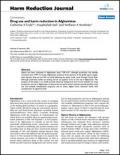
Resource | Publications,
Opium has been cultivated in Afghanistan since 1100 A.D., although production has steadily increased since 1979. Currently, Afghanistan produces three-quarters of the global opium supply, with injection drug use and HIV currently following the opium trade route through Central Asia. Although systematic studies are lacking, heroin use appears to be on the rise in Afghanistan. The purpose of this paper is to briefly provide historical background and current statistics for drug production and use in Afghanistan, to discuss the new government's policies towards problem drug use and available rehabilitation programs, and to assess Afghan harm reduction needs with consideration of regional trends.
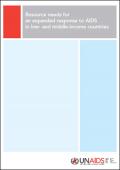
Resource | Publications,
In the four months since the High-Level Meeting on "The Global Response to AIDS: Making the Money Work – The Three Ones in Action" on March 9th 2005, the estimates for the AIDS resource needs have been refined and updated. The revisions are based on newly available information and invaluable input from the recently formed Resource Needs Steering Committee and the Resource Needs Technical Working Group.
The coverage levels for services presented in the analysis should not be considered as agreed targets, but rather the outcomes that could be expected if these resources were spent as described.
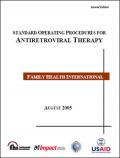
Resource | Presentations,
With significant reduction in the cost of antiretroviral (ARV) drugs, access to antiretroviral therapy (ART) has become increasingly real for people in low-resource settings. In many countries, governments have developed national guidelines on ART management to define care standards and establish protocols for such areas as eligibility criteria, drug regimens and monitoring HIV-infected clients on ART.
Standard operating procedures (SOPs) describe processes and provide instructions to maximize ART service delivery at health facilities in accordance with national guidelines. They guide clinicians in providing ART to HIV-infected clients and in evaluating performance, thereby serving as a quality assurance tool for management.
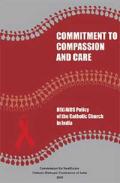
Resource | Publications,
One of the most alarming concerns about HIV/AIDS in India is the rate of the increase in the number of infected persons across the country. The first case was detected in India in 1986. By the end of 2003, less than twenty years later, the total number of persons living with HIV/AIDS was 5.1 million! The estimates from 1994 till 2000 show that the incidence has been doubled. Every year since 2000, five lakhs reported cases have been added, which may be just the tip of the iceberg. The financial burden, social constraints, and above all the personal and psychological pain and strain of those infected and affected experience are immense.
The entire Church has to continue to intensify its work and to join hands with like minded groups, to fight this disease, to curb its further spread, and to be with our sisters and brothers who are infected and affected. That is why we have developed this policy on HIV/AIDS for the Church in India. This Policy is our 'commitment to compassion and care'.
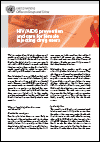
Resource | Publications,
Female injecting drug users differ from their male counterparts in terms of their background, their reasons for using drugs, and their psychosocial needs. However, most HIV/AIDS prevention and care programmes are not reaching this vulnerable group because services are designed for men. Attempts to reach and work with female injecting drug users are limited and, in fact, gender sensitive services addressing the specific needs of female injecting drug users hardly exist in most countries.
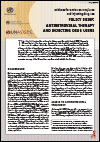
Resource | Publications,
This policy brief reviews the evidence to date on providing antiretroviral (ARV) therapy to HIV-positive injecting drug users. A number of related medical, psychological and social issues are also addressed including the need to manage drug interactions and the benefi t of harm reduction interventions in supporting optimum care for HIV-positive injecting drug users.
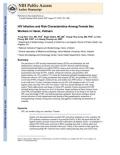
Resource | Publications,
The prevalence of HIV/sexually transmitted diseases (STDs) was determined, the risk characteristics examined, and factors associated with HIV infection identified among noninstitutionalized female sex workers (FSWs), using a cross-sectional survey with two-stage cluster sampling.
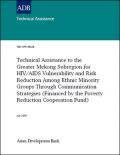
Resource | Publications,
This technical assistance (TA) aims to reduce the vulnerability to, and risk of, HIV/AIDS transmission among ethnic minority groups through communication strategies. The TA focuses on ethnic minorities that live in cross-border areas in the GMS. An Asian Development Bank (ADB) regional TA (RETA), begun in 2002 and completed in December 2004, dealt with HIV/AIDS in GMS areas. The proposed TA will build on the achievements of RETA 6083 by (i) scaling-up to address the increased risk of HIV/AIDS due to human trafficking and drug abuse; and (ii) scaling-out to include new ethnic groups prioritized by government partners.5 The TA will build on ADB’s past work in strengthening the human capital of ethnic minorities, including addressing their vulnerability to HIV/AIDS, and will coordinate with ongoing TAs on human trafficking and drug abuse in reducing structural vulnerabilities, for example citizenship and land tenure, among ethnic minorities in cross-border areas of the GMS.
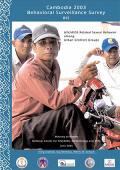
Resource | Publications,
In Cambodia, behavioral surveillance surveys (BSS) have been conducted regularly since 1997. These surveys have gathered data on sexual behaviors among brothel-based sex workers, women working for beer companies, police, military, and moto-taxi drivers in the same five provinces using a consistent methodology. For this year round (BSS VI), five new provinces were added to the sample.
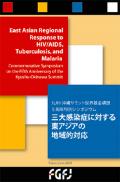
Resource | Publications,
This report contains the proceedings of a June 30, 2005, conference on the "East Asian Regional Response to HIV/AIDS, Tuberculosis, and Malaria," organized to commemorate the fifth anniversary of the Kyushu-Okinawa G8 Summit.
It is widely recognized that HIV/AIDS and other infectious diseases are among the world’s most urgent human security challenges, threatening the survival and livelihood of individuals and communities around the globe, particularly in developing countries. As many speakers emphasized, these diseases are increasingly regarded as threats to human security, and as a result they closely intersect with other threats such as poverty, hunger, in- equality, and violence, requiring a multifaceted and multisectoral response. In her talk, Dr. Kamarulzaman added several other socioeconomic factors that affect the region’s response to the spread of HIV/AIDS, such as vary- ing levels of literacy, rural to urban migration, and trafficking of women and children.





